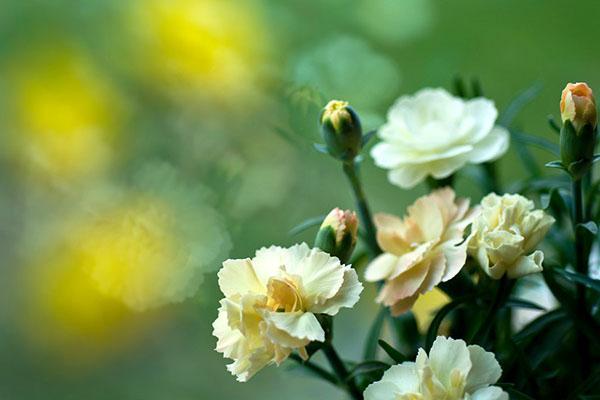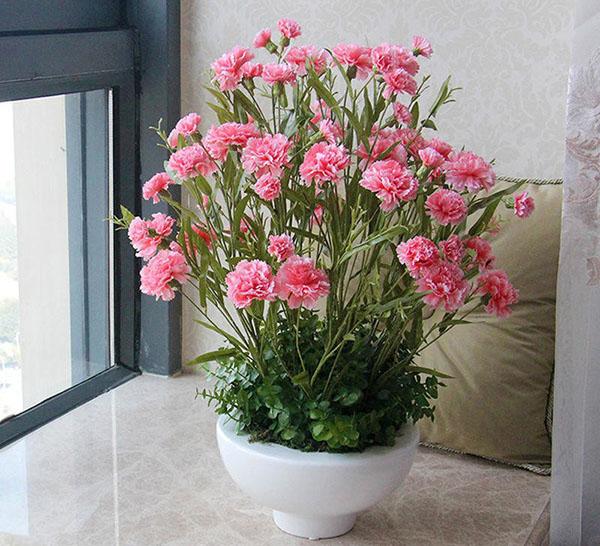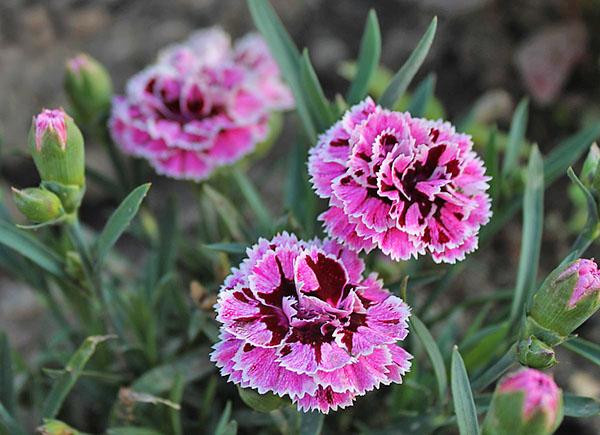How indoor carnation is grown
 Indoor carnation is appreciated by flower growers for its variegated color and pleasant aroma. Many varieties have long been traditionally grown in an apartment. In botany, there are more than 350 species of this plant, as well as dozens of hybrids that actively bloom in the summer and spring, and sometimes until a slight frost.
Indoor carnation is appreciated by flower growers for its variegated color and pleasant aroma. Many varieties have long been traditionally grown in an apartment. In botany, there are more than 350 species of this plant, as well as dozens of hybrids that actively bloom in the summer and spring, and sometimes until a slight frost.
The flat and long petals are opposite on a narrow stem and can reach a length of 10 cm. Flowers can take on any shade: from pink to lavender, with the exception of blue. Plants usually form inflorescences, but can grow in single shields.
Indoor carnation: varieties and types

The following varieties of carnations are most suitable for indoor growing:
- Chinese carnation. This plant is distinguished by a variety of shades of petals with corrugated edges: from white to red. Also, petals can combine two colors at the same time. The stem of a carnation is creeping. Carnation belongs to the group of annual plants.

- Turkish carnation. It stands out among other varieties in that its buds are collected in thyroid inflorescences with a diameter of 8-12 cm. Like the Chinese carnation, it has corrugated edges. Turkish carnation also comes in a wide variety of shades. Another distinctive feature of this variety is its undemandingness to sunlight.

- Hybrid carnation. Usually, flower growers prefer this particular variety. The hybrid carnation is one of the annual plants, its height reaches 20 cm. During the flowering period, the plant is completely overgrown with large bright buds.

- Cloves of grenadines. One type of garden carnation that works well for growing at home. It is easily recognizable by its large terry buds with corrugated edges.

All of the listed plants belong to the class of annuals.
Reproduction of carnations at home
 The first and most common way is to grow carnations from seeds.
The first and most common way is to grow carnations from seeds.
The sequence of actions is as follows:
- pour water over the hole (instead of soaking the seeds);
- place the seeds in the hole to a depth of no more than 1 cm;
- sprinkle on top with a thin layer of earth;
- moisten the ground with a spray bottle;
- cover the seedlings with plastic.
The polyethylene must be slightly opened at the edge several times a week to provide the seedlings with access to oxygen.
The first shoots appear in a couple of weeks. Before they appear, the earth needs to be moistened a little. The sprouts should be transplanted into another container in a month, the distance between the sprouts should be at least 5 cm.
In addition to the seed planting method, cuttings can be used. This will require cuttings after flowering. It is necessary to root the cuttings in a light substrate. The stalk is covered with plastic, plastic cup or jar. It must be kept covered for a month, occasionally opening it for air exchange.
You can also root the cutting in water. To do this, you need to place it in a container with a small amount of water and keep it there until roots appear. It is necessary to add water from time to time.
Growing features
 Lighting. Some varieties of cloves are light-demanding. Potted cloves are best placed on a window on the east, south or southeast side. If the carnation is grown in winter or late autumn, it is necessary to provide it with additional light sources, since the daylight hours in winter are much shorter. With absence artificial lighting during this period, indoor carnation slows down in growth, becomes smaller and blooms less than the prescribed period.
Lighting. Some varieties of cloves are light-demanding. Potted cloves are best placed on a window on the east, south or southeast side. If the carnation is grown in winter or late autumn, it is necessary to provide it with additional light sources, since the daylight hours in winter are much shorter. With absence artificial lighting during this period, indoor carnation slows down in growth, becomes smaller and blooms less than the prescribed period.
Temperature. For growing indoor carnations, the most suitable temperature is around + 20-25 ° C. But the plant can also take root at temperatures from +13 to + 35 ° C.
The soil. Carnation thrives on Chinese, sandy loam, sandy and clay soils. For normal growth, its reaction must be neutral or slightly acidic. You can make a soil mixture yourself by adding some organic fertilizers such as peat, humus, wood ash... Mineral fertilizers are also suitable, for example, potassium-phosphorus.
If it is not possible to prepare a soil mixture, you can purchase a ready-made version in which a room carnation will feel great. It will not be superfluous to install drainage, since stagnation causes root rot and the plant dies.
Care
 Caring for a room carnation at home will not take much time. Basically, this is timely watering, loosening the soil, feeding and cutting off faded inflorescences. It is necessary to cut the inflorescence together with the stem up to 5 cm. After a while, the carnation will bloom again. Many people believe that after flowering, the carnation is no longer as bright and is grown as an annual plant.
Caring for a room carnation at home will not take much time. Basically, this is timely watering, loosening the soil, feeding and cutting off faded inflorescences. It is necessary to cut the inflorescence together with the stem up to 5 cm. After a while, the carnation will bloom again. Many people believe that after flowering, the carnation is no longer as bright and is grown as an annual plant.
Watering. Pouring cloves should be avoided. It is necessary to water it only as the soil dries up. Water stagnation should not be allowed. Also, carnations do not like spraying. The plant does not tolerate dampness, so it is better not to put it in places with high humidity and lack of ventilation.
Top dressing. You also need to take care of the carnation in the pot with the help of fertilizers. Thanks to regular feeding, it grows faster and forms an increased friendly flowering. It is advisable to feed the cloves at the same time as watering. The first fertilization should be carried out when the stem height reaches 10 cm, and the second - before flowering.
Diseases
 If over-watered, cloves can be threatened by fungal root rot. If the plant is already susceptible to such a disease, it must be removed by the roots and destroyed. Sometimes a clove can hit spider mite... In this disease, the leaves on the back are covered with a white bloom. With a spider mite, the period and quality of carnation flowering is reduced. Aphids and powdery mildew are also rare.
If over-watered, cloves can be threatened by fungal root rot. If the plant is already susceptible to such a disease, it must be removed by the roots and destroyed. Sometimes a clove can hit spider mite... In this disease, the leaves on the back are covered with a white bloom. With a spider mite, the period and quality of carnation flowering is reduced. Aphids and powdery mildew are also rare.
If one of the plants turns out to be infected, it is necessary to remove it to another place, away from others!
If signs of illness have been noticed, the leaves of the plant should be washed with a soapy mixture. Do not allow soap to get on the roots. Leave the foam on the leaves for a couple of hours, then rinse thoroughly. If it was not possible to get rid of the disease with improvised means, it is better to purchase special fungicides.
Often the plants get sick due to the poor quality of the soil. Before planting, the acquired or dug land must be watered with a weak solution of potassium permanganate in order to get rid of microorganisms.
Video tutorials on carnation care